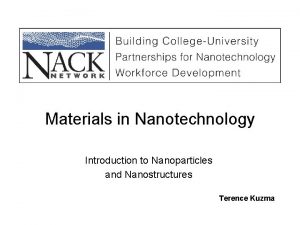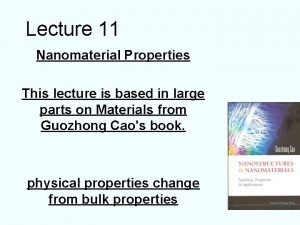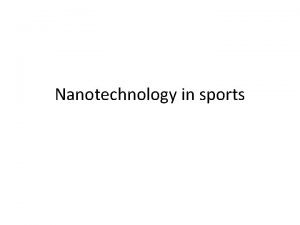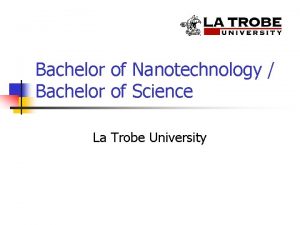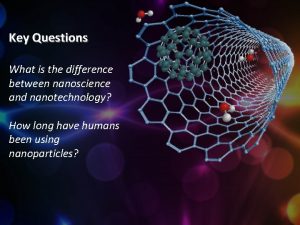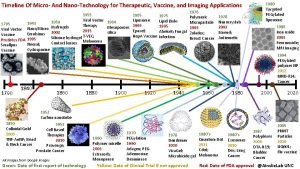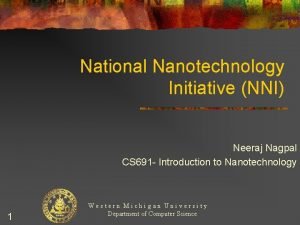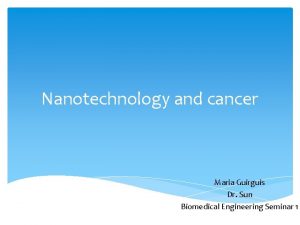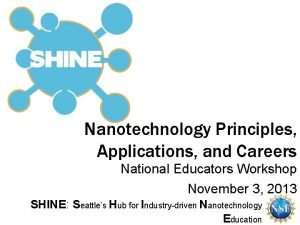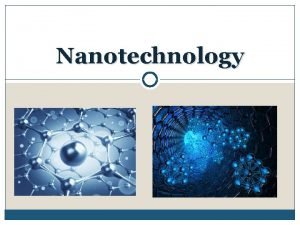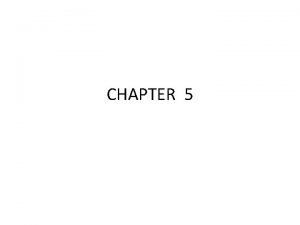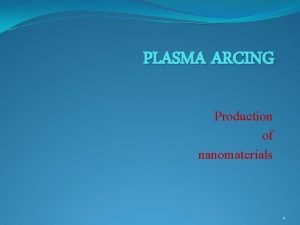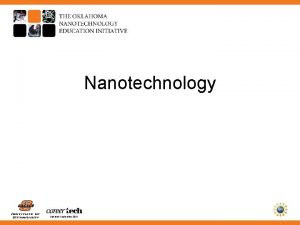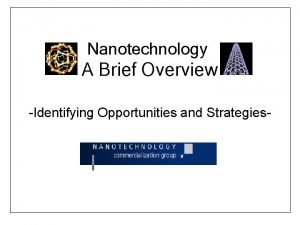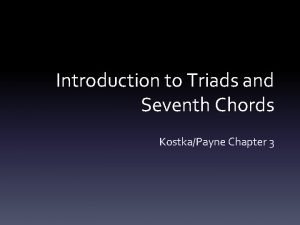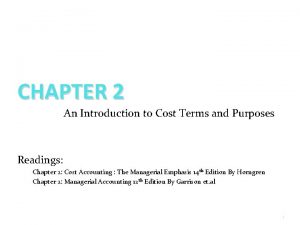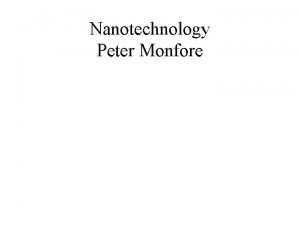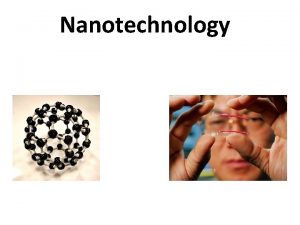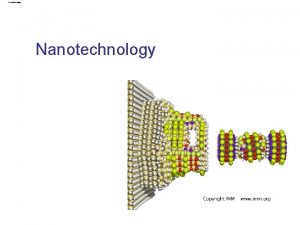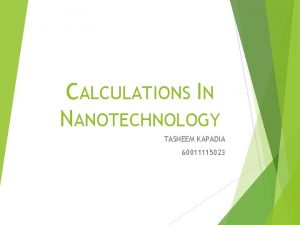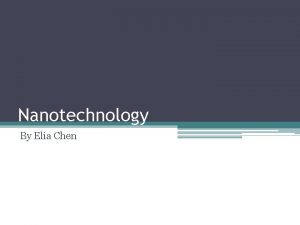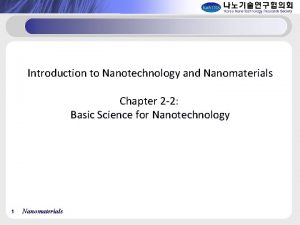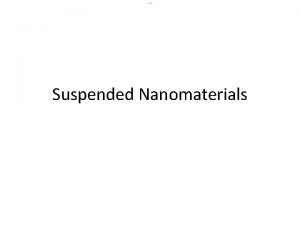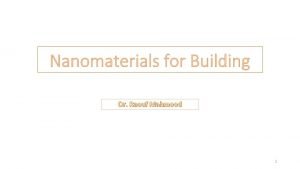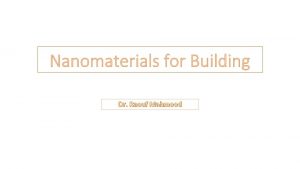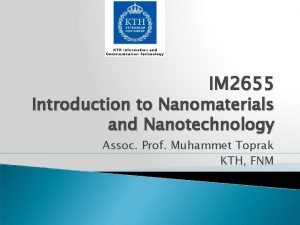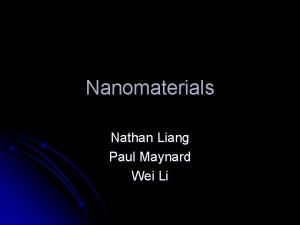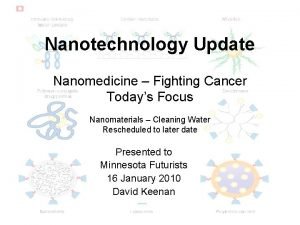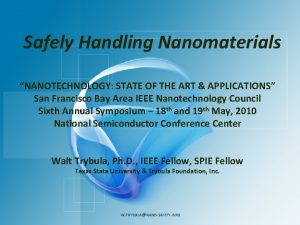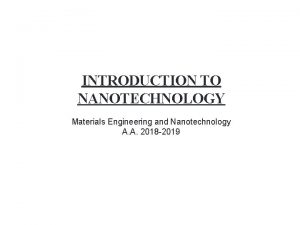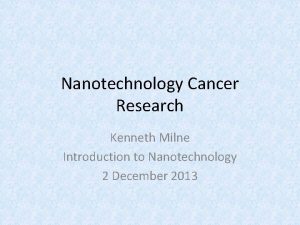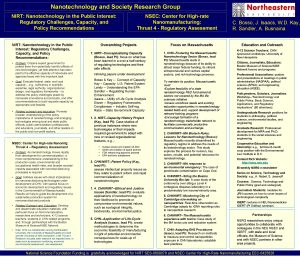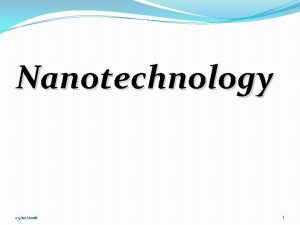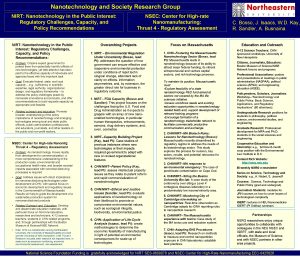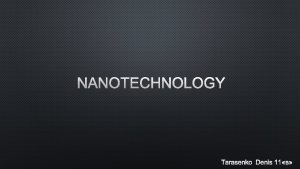Introduction to Nanotechnology and Nanomaterials Chapter 2 1

















![Basics- Crystal structure q Diamond : [110] projection § Stacking sequence : § AABBCC… Basics- Crystal structure q Diamond : [110] projection § Stacking sequence : § AABBCC…](https://slidetodoc.com/presentation_image_h2/5b95b7e156b4ef480b33e209629fe103/image-18.jpg)

![Basics- Crystal structure q Zinc Blende : [110] projection §A § §C § TYPE Basics- Crystal structure q Zinc Blende : [110] projection §A § §C § TYPE](https://slidetodoc.com/presentation_image_h2/5b95b7e156b4ef480b33e209629fe103/image-20.jpg)

![Basics- Crystal structure q Wurzite : [110] projection A B Stacking sequence : A Basics- Crystal structure q Wurzite : [110] projection A B Stacking sequence : A](https://slidetodoc.com/presentation_image_h2/5b95b7e156b4ef480b33e209629fe103/image-22.jpg)












- Slides: 34

Introduction to Nanotechnology and Nanomaterials Chapter 2 -1: Basic Science for Nanotechnology 1 Nanomaterials

Contents Chapter 1: Introduction (서론) Chapter 2: Basic Science for Nanotechnology (나노과학의 기초) Chapter 3: Solution-based Synthesis of Nanomaterials (용액기반의 나노재료 합성) Chapter 4: Vapor-based Synthesis of Nanomaterials(기상공정을 통한 나노재료의 합성) Chapter 5: Fabrication of Nanostructure (나노구조 공정) Chapter 6: Properties and Applications (특성 및 응용) Chapter 7: Characterization of Nanostructure (나노소재의 분석) 2 Nanomaterials

Basics 1. Crystal structure (General) 2. Surface Energy (Thermodynamics) 3. Kinetics (Nucleation and Growth, Phase Transformation) 4. Surface Passivation and Consolidation 5. Electronic and Optical Properties of Nanostructure 3 Nanomaterials

Basics §We will cover the basics of crystal structure. §Then, covering the atomic structure and thermodynamics of surface. §We do know that atoms bond each other to form solid structure. §It forms crystalline structure which does have a long range of ordered arrangement. §Sometimes, it forms a disordered solid structure which we call as an “amorphous”. §Bonding directionality is an important parameter to consider the formation of amorphous structure. §Metallic bonding §Ionic bonding §Covalent bonding - which one has a bonding directionality? 4 Nanomaterials

Basics- Crystal structure q Crystalline vs. amorphous Crystalline Si. O 2 Amorphous Si. O 2 Crystalline Au Long range order 5 Nanomaterials Short range order Crystalline Si Matrix Amorphous Si. O 2 10 nm

Basics §Basics of Crystallography and Crystal Structure §Should understand how the seven crystal system and 14 Bravais lattices were derived. §Should understand how we understand the complicate structure. §Starting from the closed packed structure of FCC and HCP §Then understand the interstitial sites of octahedral and tetrahedral §Then building structures of ionic compound and covalently bonded structure. §Of course, you have to review how one can analyze the crystal structure based on diffraction theory. 6 Nanomaterials

Basics- Crystal structure q Definition of Crystal A crystal is an anisotropic, homogeneous body consisting of a threedimensional periodic ordering of atoms, ions or molecules q Definition of Lattice A lattice means a three-dimensional array of points coinciding with atom positions (the space arrangement of equivalent sites in a crystal ) q Lattice Parameters 7 Nanomaterials

Basics- Crystal structure q Crystal Structure Crystal structure = Lattice + Basis 8 Nanomaterials

Basics- Crystal structure q Definition of Crystallographic direction is defined as a line between two points, or a vector. Note that the direction of [uvw] describes not only a line through the origin and the point uvw, but the infinite set of lines which are parallel to it. 9 Nanomaterials

Basics- Crystal structure q Definition of Crystallographic plane The values ( h k l ) are called Miller indices, and they are defined as the smallest integral multiples of the reciprocals of the plane intercepts of axis. 10 Nanomaterials

Basics- Crystal structure §Should understand how the seven crystal system and 14 Bravais lattices were derived. q Seven Crystal Systems 11 Nanomaterials

Basics- Crystal structure q 14 Bravais Lattice 12 Nanomaterials

Interstitial Sites (Interstices) Geometry Coordination # 2 < 0. 155 3 (Trigonal) 0. 155 - 0. 225 4 (Tetragonal) 0. 225 - 0. 414 6 (Octahedral) 0. 414 - 0. 732 8(Cubic) 13 Cation-Anion radius ratio Nanomaterials 0. 732 - 1. 0

Basics- Crystal structure q Close Packed Structure- FCC 14 Nanomaterials

Basics- Crystal structure q Close Packed Structure- FCC (110) projection Projection of (111) plane A 15 Nanomaterials B C A

Basics- Crystal structure q Close Packed Structure- HCP 16 Nanomaterials

Basics- Crystal structure q Diamond Structure C (diamond), Si, Ge 17 Nanomaterials
![Basics Crystal structure q Diamond 110 projection Stacking sequence AABBCC Basics- Crystal structure q Diamond : [110] projection § Stacking sequence : § AABBCC…](https://slidetodoc.com/presentation_image_h2/5b95b7e156b4ef480b33e209629fe103/image-18.jpg)
Basics- Crystal structure q Diamond : [110] projection § Stacking sequence : § AABBCC… CB 18 BA Nanomaterials AC CB BA A

Basics- Crystal structure q Zinc Blende Ga. As 19 Nanomaterials
![Basics Crystal structure q Zinc Blende 110 projection A C TYPE Basics- Crystal structure q Zinc Blende : [110] projection §A § §C § TYPE](https://slidetodoc.com/presentation_image_h2/5b95b7e156b4ef480b33e209629fe103/image-20.jpg)
Basics- Crystal structure q Zinc Blende : [110] projection §A § §C § TYPE II §B § TYPE I §A §[110] 20 Nanomaterials §[111]

Basics- Crystal structure q Wurzite 21 Nanomaterials
![Basics Crystal structure q Wurzite 110 projection A B Stacking sequence A Basics- Crystal structure q Wurzite : [110] projection A B Stacking sequence : A](https://slidetodoc.com/presentation_image_h2/5b95b7e156b4ef480b33e209629fe103/image-22.jpg)
Basics- Crystal structure q Wurzite : [110] projection A B Stacking sequence : A A B … A B B C C A 22 Nanomaterials A B Octahedral coordination B C C A Tetrahedral coordination

Basics- Crystal structure q Carbon - diamond - graphite 23 Nanomaterials §www. spmtips. com/products/hopg/

Basics- Crystal structure q Carbon - graphene - fullerenes (C 60) - nanotube

Basics- Crystal structure q Carbon-Classification of carbon nanotubes - Single-wall CNT, double-wall CNT, multi-wall CNTs - Zigzag and armchair nanotubes, chiral nanotube SWCNT DWCNT Thin-MWCNT MWNCT

Basics- Crystal structure q Carbon-Classification of carbon nanotubes - Zigzag and armchair nanotubes, chiral nanotube

Basics- Defects q Point Defect - Vacancy - Interstitial - Impurities (Dopant) Defect concentration determined By thermodynamics

Basics- Defects

Basics- Defects

Basics- Defects q Line Defect (dislocation) - edge - screw Dislocation line Burgers vector, b a)

Basics- Defects q Line Defect (dislocation) - mixed Mixed Edge 31 Nanomaterials Screw

Basics- Defects q Line Defect (dislocation) - observation of dislocation high resolution transmission electron microscope image electron beam incident along an <011> zone of Si 32 Nanomaterials

Basics- Defects q Line Defect (dislocation) - lattice fringe image of dislocation 33 Nanomaterials

Basics- Defects q Line Defect (dislocation) - diffraction contrast transmitted beam-bright field image-dislocation-dark diffracted beam-dark field image -dislocation-bright 34 Nanomaterials
 Simple cubic unit cell
Simple cubic unit cell Hardness of nanomaterials
Hardness of nanomaterials Magnetic properties of nanomaterials
Magnetic properties of nanomaterials Tennis ball nanotechnology
Tennis ball nanotechnology Advantages and disadvantages of nanotechnology
Advantages and disadvantages of nanotechnology Difference between nanoscience and nanotechnology
Difference between nanoscience and nanotechnology Journal of nanoscience and nanotechnology sci
Journal of nanoscience and nanotechnology sci Timeline of nanotechnology
Timeline of nanotechnology Nbic, gnr, grain, bang
Nbic, gnr, grain, bang Nanotechnology for kids
Nanotechnology for kids Nanotechnology fact or myth
Nanotechnology fact or myth Disadvantages of nanotechnology
Disadvantages of nanotechnology Nanotechnology
Nanotechnology Nanotechnology definition
Nanotechnology definition Conclusion of nanotechnology
Conclusion of nanotechnology Interpretations of moore's law assert that:
Interpretations of moore's law assert that: Plasma arcing method
Plasma arcing method Nanotechnology definition
Nanotechnology definition What is nanotechnology
What is nanotechnology Examples of discourse communities
Examples of discourse communities Body paragraph
Body paragraph Chapter 52 an introduction to ecology and the biosphere
Chapter 52 an introduction to ecology and the biosphere Chaparral climograph
Chaparral climograph Introduction to management chapter 1
Introduction to management chapter 1 Waistline
Waistline Chapter 1 introduction to accounting
Chapter 1 introduction to accounting 664-765-4342
664-765-4342 Accounting in business chapter 1
Accounting in business chapter 1 Introduction to accounting and business chapter 1
Introduction to accounting and business chapter 1 An introduction to cost terms and purposes
An introduction to cost terms and purposes Chapter 1 introduction to human anatomy and physiology
Chapter 1 introduction to human anatomy and physiology Chapter 1 introduction to accounting
Chapter 1 introduction to accounting Introduction and mathematical concepts
Introduction and mathematical concepts Computer programming chapter 1
Computer programming chapter 1 Forensic science chapter 1
Forensic science chapter 1
